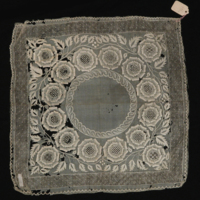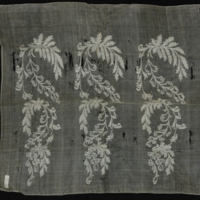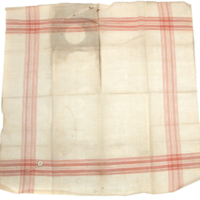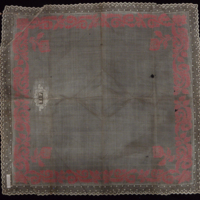Handkerchief
Text
Logbook of items (a-c):
3 stitched handkerchiefs from piña fibers by the Tagalog
Original map/file (a-c):
3 stitched handkerchiefs from piña fibers by the Tagalog.
[added later:]
a) 42 x 42 cm
b) 47 x 42 cm (with stitchings)
c) 55 x 52 cm (with red pattern woven in & lace trimming)
Share this
Media
Images
Map Ethnographic Museum at the University of Zurich (Völkerkundemuseum der Universität Zürich)
Metadata
Rights
© Ethnographic Museum of the University of Zurich, photo: Silvia Luckner
Identifier
00626b
Origin
Manila
Provenance
Purchased from Mrs Labhart-Lutz.
She was the widow of J. C. Labhart who had died in Manila in 1887. As of yet, we know more of him than of her. Labhart was born in Steckborn, canton of Thurgau, in 1825. In 1846, he took employment with the Swiss trading company Gebrüder Tobler & Co. in Manila. Two years later, he became partner of the newly named Eugster, Labhart & Co. In his extensive obituary for J. C. Labhart, the Austrian scholar Ferdinand Blumentritt, close friend of José Rizal and other Filipino intellectuals of the burgeoning independence movement, stresses the eminent services to «our fatherland», that Labhart rendered to the Austro-Hungarian Empire as its longstanding Consul in the Philippines. He calls him an ingenious autodidact who published two articles in learned journals on Manila-hemp. Due to Labhart’s regular parcels with newspaper clippings and letters to Blumentritt, the latter writes on July 13, 1889: «Ich kann ruhig sagen, dass in der ganzen langen Reihe von Jahren, in denen ich mich des Verkehrs mit dem verewigten Freunde erfreute, ich durch ihn durch die geringsten Vorfälle im Archipel mit Sofortigkeit und Treue unterrichtet wurde.» [It is due to say that I was informed of the smallest incidents on the archipelago immediately and truthfully in this long course of years that I have been communicating with the hereby immortalized friend. Translated by Annette Hug]
She was the widow of J. C. Labhart who had died in Manila in 1887. As of yet, we know more of him than of her. Labhart was born in Steckborn, canton of Thurgau, in 1825. In 1846, he took employment with the Swiss trading company Gebrüder Tobler & Co. in Manila. Two years later, he became partner of the newly named Eugster, Labhart & Co. In his extensive obituary for J. C. Labhart, the Austrian scholar Ferdinand Blumentritt, close friend of José Rizal and other Filipino intellectuals of the burgeoning independence movement, stresses the eminent services to «our fatherland», that Labhart rendered to the Austro-Hungarian Empire as its longstanding Consul in the Philippines. He calls him an ingenious autodidact who published two articles in learned journals on Manila-hemp. Due to Labhart’s regular parcels with newspaper clippings and letters to Blumentritt, the latter writes on July 13, 1889: «Ich kann ruhig sagen, dass in der ganzen langen Reihe von Jahren, in denen ich mich des Verkehrs mit dem verewigten Freunde erfreute, ich durch ihn durch die geringsten Vorfälle im Archipel mit Sofortigkeit und Treue unterrichtet wurde.» [It is due to say that I was informed of the smallest incidents on the archipelago immediately and truthfully in this long course of years that I have been communicating with the hereby immortalized friend. Translated by Annette Hug]
Acquisition Date
1889?
Display status
Not on display
Acknowledgements
Contributed by Dr. Andreas Isler of University of Zurich / Ethnographic Museum and studiyo-filipino.ch, Translated from German by Lenny Bugayong, Photo and Information University of Zurich / Ethnographic Museum
Official Website
Collection
Cite this Page
“Handkerchief,” Mapping Philippine Material Culture, accessed April 26, 2024, https://philippinestudies.uk/mapping/items/show/29300.
Geolocation
Sensitive Content
Mapping Philippine Material Culture collates digital material from institutions, and some of this material is inherently colonial and contains words, terms and phrases that are inaccurate, derogatory and harmful towards Filipino and Filipino diasporic communities. Catalogue transcriptions, book titles, exhibition titles and museum titles may contain harmful terms. We recognise the potential for the material to cause physical and mental distress as well as evoke strong emotions. Owing to the scale of the collection’s data, a process to implement sensitive-content warnings in the displayed data is still incomplete. The material within the catalogue does not represent Mapping Philippine Material Culture’s views. Mapping Philippine Material Culture maintains a strong anti-colonial, anti-racist position and affirms its support for centring the humanity of historically marginalised and disenfranchised communities.
Facebook Twitter



